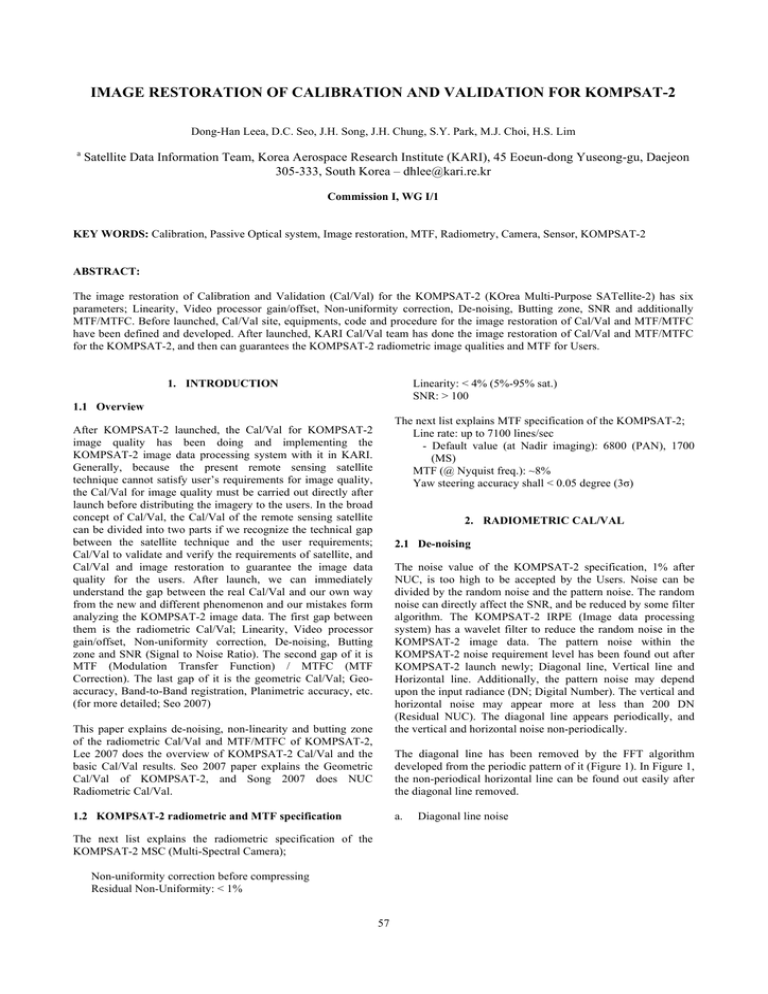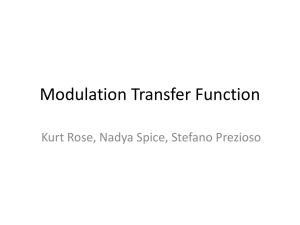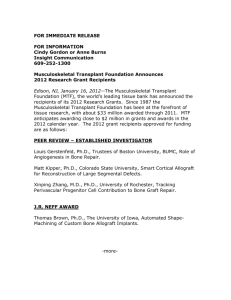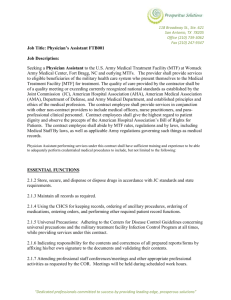IMAGE RESTORATION OF CALIBRATION AND VALIDATION FOR KOMPSAT-2
advertisement

IMAGE RESTORATION OF CALIBRATION AND VALIDATION FOR KOMPSAT-2 Dong-Han Leea, D.C. Seo, J.H. Song, J.H. Chung, S.Y. Park, M.J. Choi, H.S. Lim a Satellite Data Information Team, Korea Aerospace Research Institute (KARI), 45 Eoeun-dong Yuseong-gu, Daejeon 305-333, South Korea – dhlee@kari.re.kr Commission I, WG I/1 KEY WORDS: Calibration, Passive Optical system, Image restoration, MTF, Radiometry, Camera, Sensor, KOMPSAT-2 ABSTRACT: The image restoration of Calibration and Validation (Cal/Val) for the KOMPSAT-2 (KOrea Multi-Purpose SATellite-2) has six parameters; Linearity, Video processor gain/offset, Non-uniformity correction, De-noising, Butting zone, SNR and additionally MTF/MTFC. Before launched, Cal/Val site, equipments, code and procedure for the image restoration of Cal/Val and MTF/MTFC have been defined and developed. After launched, KARI Cal/Val team has done the image restoration of Cal/Val and MTF/MTFC for the KOMPSAT-2, and then can guarantees the KOMPSAT-2 radiometric image qualities and MTF for Users. Linearity: < 4% (5%-95% sat.) SNR: > 100 1. INTRODUCTION 1.1 Overview The next list explains MTF specification of the KOMPSAT-2; Line rate: up to 7100 lines/sec - Default value (at Nadir imaging): 6800 (PAN), 1700 (MS) MTF (@ Nyquist freq.): ~8% Yaw steering accuracy shall < 0.05 degree (3σ) After KOMPSAT-2 launched, the Cal/Val for KOMPSAT-2 image quality has been doing and implementing the KOMPSAT-2 image data processing system with it in KARI. Generally, because the present remote sensing satellite technique cannot satisfy user’s requirements for image quality, the Cal/Val for image quality must be carried out directly after launch before distributing the imagery to the users. In the broad concept of Cal/Val, the Cal/Val of the remote sensing satellite can be divided into two parts if we recognize the technical gap between the satellite technique and the user requirements; Cal/Val to validate and verify the requirements of satellite, and Cal/Val and image restoration to guarantee the image data quality for the users. After launch, we can immediately understand the gap between the real Cal/Val and our own way from the new and different phenomenon and our mistakes form analyzing the KOMPSAT-2 image data. The first gap between them is the radiometric Cal/Val; Linearity, Video processor gain/offset, Non-uniformity correction, De-noising, Butting zone and SNR (Signal to Noise Ratio). The second gap of it is MTF (Modulation Transfer Function) / MTFC (MTF Correction). The last gap of it is the geometric Cal/Val; Geoaccuracy, Band-to-Band registration, Planimetric accuracy, etc. (for more detailed; Seo 2007) 2. RADIOMETRIC CAL/VAL 2.1 De-noising The noise value of the KOMPSAT-2 specification, 1% after NUC, is too high to be accepted by the Users. Noise can be divided by the random noise and the pattern noise. The random noise can directly affect the SNR, and be reduced by some filter algorithm. The KOMPSAT-2 IRPE (Image data processing system) has a wavelet filter to reduce the random noise in the KOMPSAT-2 image data. The pattern noise within the KOMPSAT-2 noise requirement level has been found out after KOMPSAT-2 launch newly; Diagonal line, Vertical line and Horizontal line. Additionally, the pattern noise may depend upon the input radiance (DN; Digital Number). The vertical and horizontal noise may appear more at less than 200 DN (Residual NUC). The diagonal line appears periodically, and the vertical and horizontal noise non-periodically. This paper explains de-noising, non-linearity and butting zone of the radiometric Cal/Val and MTF/MTFC of KOMPSAT-2, Lee 2007 does the overview of KOMPSAT-2 Cal/Val and the basic Cal/Val results. Seo 2007 paper explains the Geometric Cal/Val of KOMPSAT-2, and Song 2007 does NUC Radiometric Cal/Val. The diagonal line has been removed by the FFT algorithm developed from the periodic pattern of it (Figure 1). In Figure 1, the non-periodical horizontal line can be found out easily after the diagonal line removed. a. 1.2 KOMPSAT-2 radiometric and MTF specification The next list explains the radiometric specification of the KOMPSAT-2 MSC (Multi-Spectral Camera); Non-uniformity correction before compressing Residual Non-Uniformity: < 1% 57 Diagonal line noise The International Archives of the Photogrammetry, Remote Sensing and Spatial Information Sciences. Vol. XXXVII. Part B1. Beijing 2008 The Linearity value of the KOMPSAT-2 specification, 4% from 5% to 95% saturation level, is too high to be accepted by the Users. The non-linearity of KOMPSAT-2 image data has been analyzed with the uniform areas of several DN values, so that three regions for grey level (DN) can be divided in Figure 3. The vertical and horizontal noise can be removed with each region of the next; Region 2: HF NUC in MSC on-board Region 1: Algorithm for removing Residual NUC (Vertical line); Stronger Non-Linear CCD Response in Region 1 Region 3: Difference between Even and Odd pixel value Figure 1. Up: Raw image data, Bottom: Diagonal line removed The non-linearity can affect the next; Butting zone Vertical & Horizontal line MS-band Fluctuation Normalization with Video gain & NUC MTF Curve MTF Correction Absolute radiometric Cal/Val 2.3 Butting zone Figure 2. FFT filter in frequency domain to remove the vertical and horizontal noise line KOMPSAT-2 MSC PAN has three CCDs of 5200 pixels. There are two butting zone between CCDs that decrease the brightness gradually (Figure 5). Because there is some non-linearity in the butting zone, we have developed three more algorithms to reduce it; Scatter plot, BSM (Butting zone Smoothing Method) and Dispersion method. b. Non-periodical vertical and horizontal noise To remove the non-periodical vertical and horizontal noise line, the FFT method in frequency domain has been used. In Figure 2, the FFT filter has been analyzed carefully only to remove the vertical and horizontal noise line without any blurring. 100 (overlap) PAN2 PAN4 50% 72 Figure 3. Left: Vertical & Horizontal Pattern noise, Bottom: Removed by FFT method 72 Figure 5. The brightness degradation in the Butting zone 2.2 Non-Linearity DN Region 3 Region 1 Region 2 Figure 6. Up: The butting zone between PAN2 & PAN4, Bottom: Corrected Radiance Figure 4. Non-linearity of KOMPSAT-2 image data 58 The International Archives of the Photogrammetry, Remote Sensing and Spatial Information Sciences. Vol. XXXVII. Part B1. Beijing 2008 PAN2 PAN4 Get a Dispersion Value from this part 1.01 Get Gain/Offset of every pixel with the Dispersion Value of it 1 0.99 0.98 0.97 0.96 0.95 0.94 Figure 7. Non-linearity in Butting zone 0.93 0.92 0.91 9500 The butting zone has the difference in grey level, contrast, clearness, discontinuity, etc. between each CCDs, and strong non-linear CCD response (Figure 7). To reduce the butting zone issues, the relation, the scatter plot between PAN2 / PAN4 and PAN3 / PAN5 has been searched for all grey level possibly with so many KOMPSAT-2 image data (Figure 7 right). In Figure 7, if KOMPSAT-2 MSC be perfect system, it should be red line, but we got the blue line of the non-linearity depended upon the grey level., The right image in figure 8 is corrected by the result of the scatter plot between PAN2 and PAN4, but there is still remnant in butting zone. 9600 9700 9800 9900 10000 10100 10200 10300 10400 10500 Figure 10. The principle of Dispersion method In Figure 11, the left image is only corrected with LF NUC + Scatter Plot, the middle image is corrected with LF NUC + BSM + Scatter Plot, and the right image is corrected with LF NUC + BSM + Scatter Plot + Dispersion method. The right image can be clearer than the left and the middle. If LF NUC + BSM + Scatter Plot + Dispersion method can be applied to the KOMPSAT-2 image data, there are no more butting zone issues. LF NUC+BSM+ ScatterPlot LF NUC+ScatterPlot LF NUC+BSM+ ScatterPlot+Dispersion Figure 11. The result of BSM + Scatter Plot + Dispersion method in butting zone Figure 8. Up: Raw image data, Bottom: corrected by the scatter plot 3. MTF AND MTFC To remove the butting zone issues in all case of the KOMPSAT-2 image data, two more algorithm has been developed; BSM (Butting zone Smoothing Method) and Dispersion method. To fully remove the butting issues, do the next sequence; LF NUC → BSM → Scatter Plot → Dispersion. In figure 9, the principle of BSM is the smoothing of the middle DN value of all lines at the butting zone. The weak point of the BSM is the case of the right of Figure 9. 3.1 MTF Value 0.0 0.2 0.4 0.6 0.8 1.0 1.2 1.4 1.6 1.8 1.0 2.0 1.0 0.9 0.8 0.8 PAN2 Relative Contrast 0.7 In case, Weak point PAN4 After LF NUC Mean value 0.6 0.6 0.5 0.4 0.4 0.3 6% 0.2 0.2 0.1 0.0 0.0 -0.1 -0.2 Figure 9. The principle of BSM 0.0 0.2 0.4 0.6 0.8 1.0 Lines/m 1.2 1.4 1.6 1.8 -0.2 2.0 Sep. 3, 2006 Figure 12. The beginning MTF value of the KOMPSAT-2 with Siemens target at Stennis Space Center in USA 59 The International Archives of the Photogrammetry, Remote Sensing and Spatial Information Sciences. Vol. XXXVII. Part B1. Beijing 2008 The MTF value of PAN at nyquist frequency is 8% in the KOMPSAT-2 specification. The beginning MTF value was less than 8% (~ 6%) (Figure 12), so that we has analyzed the factors of the KOMPSAT-2 MTF; AOCS stability & bias, noise, TDI line rate error and Yaw steering error. F ul l Wi d th at H a lf Ma xim u m 1 0.9 N orm al iz ed Di fferenti ati on va l ue 0.8 0.7 0.6 0.5 0.4 0.3 0.2 0.1 FWHM = 2.5373 [Pixel] 0 -6 -4 -2 0 2 4 6 Pix el Figure 15. Non-symmetry of the KOMPSAT-2 PSF 1.2 1.0 0.8 0.6 0.4 across Figure 13. The analysis result of TDI line rate and Yaw steering for MTF 0.0 -8 MTF (Along) ※ N ight Lam p im age in M ongol; Feb. 22, 2007 -2 0 2 4 6 8 MTF Along 0.8 Normalized value 2 -4 MTF Along at Nyquist = 6.8655% The optimal PSF could be measured from nine Night lamp images (Figure 17, Right), and then the MTF kernel (Figure 18) has been generated by the Wiener filter (Figure 17, Left). The size of the generated MTF kernel is 13 x 13. 0.7 Point Source -6 Figure 16. PSF from the Night images 1 0.9 ※ A fter upload A O C S K P D (Y aw steering) along 0.2 0.6 0.5 0.4 0.3 4 0.2 6 Pixel 0.1 0 8 0 0.05 0.1 0.15 0.2 0.25 0.3 Normalized frequency 0.35 0.4 0.45 0.5 MTF (Across) 1 10 MTF Across P SF PS PSF F 0.9 MTF Across at Nyquist = 7.0444% 12 h(x,y) h (x,y) 0.8 Inp ut Input Input Spatial=> frequ fre quency ency 6 8 Pixel 10 0.7 12 Normalized value 4 1.5 Transfo Tran sform rm Transfo rm 0.6 OTF OTF O TF MTF Convolution Convolu tion Convolution with Output utput with O Ou tpu t 0.5 H(v1 , v2) H(v1, v2) Q(v1, Q (v1, v2) Q(v1, v2) hhII(x,y (x,y) y(x,y (x,y)) ⊗ y(x,y) y(x,y)) 1 0.5 0.4 Inve Inverse MTF Inverse rse MTF 0.3 Inve Inverse rse Inverse Filter K Ke ernel rnel Ker nel H HII(v1, v2 (v1 , v2) v2)) 0 1 2 3 4 5 6 7 8 9 10 11 12 13 -0.5 hII(x,y (x,y) (x,y)) 0.2 Inve Inverse Fourie In verrse se Fourier Fourierr 0.1 0 2 a(x,y a(x,y) a(x,y)) Fourier Fou rier rier 2 0 0.05 0.1 0.15 0.2 0.25 0.3 Normalized frequency 0.35 0.4 0.45 Transfo Transforrm m Transform freque ncy=>spati al freq uency=>spatial 0.5 -1 -1.5 Figure 17. Left: Wiener filter to generate the MTF kernel, Right: MTF kernel (13x13) for MTFC Figure 14. The MTF value from the Night lamp In Figure 13, we have found out the effect of the TDI line rate could be neglected, but the Yaw steering value was higher than the KOMPSAT-2 specification (0.05 deg). After KARI AOCS team uploaded the AOCS calibration data included with the Yaw steering offset at Feb 14, 2007, the MTF value of KOMPSAT-2 image data was measured again with the image from the Night lamp (Figure 14), and then we got the around ‘7%’ of the MTF value. 3.2 MTF Compensation (Correction) We have studied the difference between ‘7%’ from the Night lamp and ‘8%’ from the KOMPSAT-2 specification, and then the reason of it; Non-symmetry of the KOMPSAT-2 MTF curve (Figure 15) Non-linearity in less than 200 DN Figure 18. Left: Raw image data, Right: MTFC image data The KOMPSAT-2 IRPE has a framelet wavelet de-convolution algorithm (Jeong) for the MTFC and the de-noising. In Figure 18, MTFC image data is better quality than raw one. The MTF value of the MTFC image data is 11 ~ 12 %. But, there is a minor problem of it; aliasing. This difference can be compensated by MTFC, so that the optimal Point Spread Function (PSF) for the KOMPSAT-2 image data has to be needed for it. 60 The International Archives of the Photogrammetry, Remote Sensing and Spatial Information Sciences. Vol. XXXVII. Part B1. Beijing 2008 4. CONCLUSION For one-half year after KOMPSAT-2 launch, KARI Cal/Val team has carried out the Calibration and Validation to guarantee the image quality of KOMPSAT-2 MSC image data, so that the Users can be taken the KOMPSAT-2 image data with good image quality now. Nevertheless, there is much room for more enhancements of the image quality of the KOMPSAT-2 image data; MTFC, Reduce noise, Geo-accuracy, Band-to-Band registration, Absolute radiometric calibration, Users Manual, etc. REFERENCE Lee, D., 2008, Summary of Calibration and Validation for KOMPSAT-2, ISPRS2008 Seo, D., 2008, KOMPSAT-2 direct sensor modeling and geometric calibration/validation, ISPRS2008 B. Jeong, M. Choi, H.O. Kim, A construction of symmetric tight wavelet frames from quasi-interpolatory subdivision masks and their applications, International Journal of Wavelets, Multiresolution and Information Processing, Accepted. 61 The International Archives of the Photogrammetry, Remote Sensing and Spatial Information Sciences. Vol. XXXVII. Part B1. Beijing 2008 62





